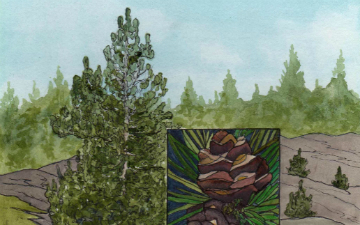| Whitebark Pine | |
|---|---|
 |
|
| A stand of Whitebark Pines | |
| Conservation status | |
| Scientific classification | |
| Kingdom: | Plantae |
| Division: | Pinophyta |
| Class: | Pinopsida |
| Order: | Pinales |
| Family: | Pinaceae |
| Genus: | Pinus |
| Subgenus: | Strobus |
| Species: | P. albicaulis |
| Binomial name | |
| Pinus albicaulis Engelm. |
|
 |
|
Pinus albicaulis, known commonly as Whitebark Pine, Pitch Pine, Scrub Pine, and Creeping Pine occurs in the mountains of the Western United States and Canada, specifically the subalpine areas of the Sierra Nevada, the Cascade Range, the Pacific Coast Ranges, and the northern Rocky Mountains – including the Greater Yellowstone Ecosystem. It shares the common name Creeping Pine with several other “creeping pine” plants.
The Whitebark Pine is typically the highest-elevation pine tree of these mountains, marking the tree line. Thus, it is often found as krummholz, trees dwarfed by exposure and growing close to the ground. In more favourable conditions, trees may grow to 20 meters (66 ft) in height, although some can reach up to 27 meters (89 ft).
Characteristics
Whitebark Pine (Pinus albicaulis) is a member of the white pine group, Pinus subgenus Strobus, section Strobus and like all members of that group, the leaves (‘needles’) are in fascicles (bundles) of five, with a deciduous sheath. This distinguishes Whitebark Pine and relatives from the Lodgepole Pine (Pinus contorta), with two needles per fascicle, and Ponderosa Pine (Pinus ponderosa) and Jeffrey Pine (Pinus jeffreyi), which both have three per fascicle; these three all also have a persistent sheath at the base of each fascicle.
Distinguishing Whitebark Pine (Pinus albicaulis), from the related Limber Pine (Pinus flexilis), also a “white pine,” is much more difficult, and requires seed or pollen cones. In Pinus albicaulis, the cones are 4–7 centimeters (1.6–2.8 in) long, dark purple when immature, and do not open on drying, but the scales easily break when they are removed by Clark’s Nutcracker (see below) to harvest the seeds. In Pinus flexilis, the cones are 6–12 centimeters (2.4–4.7 in) long, green when immature, and open to release the seeds; the scales are not fragile. Whitebark Pines rarely have intact old cones lying under them, whereas Limber Pines usually do. The pollen cones of Whitebark Pine (Pinus albicaulis) are scarlet, and yellow in Limber Pine (Pinus flexilis).
Whitebark Pine (Pinus albicaulis) can also be hard to distinguish from Western White Pine (Pinus monticola) in the absence of cones. However, Whitebark Pine needles are entire (smooth when rubbed gently in either direction), whereas Western White Pine needles are finely serrated (feeling rough when rubbed gently from tip to base). Whitebark Pine needles are also usually shorter, 4–7 centimeters (1.6–2.8 in) long, overlapping in size with the larger 5–10 centimeters (2.0–3.9 in) needles of the Western White Pine.
The Whitebark Pine, Pinus albicaulis, at Mount Rainier National Park.
The Pinus albicaulis leaves are in fascicles (bundles) of five, and the cone is dark purple when immature (Mount Rainier National Park).
http://en.wikipedia.org/wiki/Whitebark_pine







